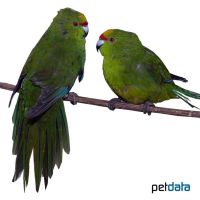Yellow-fronted Parakeet (Cyanoramphus auriceps)
| Yellow-fronted Parakeet Cyanoramphus auriceps | |
|---|---|
| Name | Yellow-fronted Parakeet |
| Name Lat. | Cyanoramphus auriceps |
| Family | Parrots |
| Family lat. | Psittacidae |
| Order | Parrots |
| Order lat. | Psittaciformes |
| Origin | New Zealand |
| Climate | Temperate - subtropical |
| Diet | Large Parakeet seed, veggies, fruits |
| Keeping | Pair, group |
| Care Level | Easy |
| Reproduction | Cavity nest |
| Life Span | 15-20 years |
| Protection | CITES Appendix II; EC Annex B |
| Metric Units | |
| Size | 23 cm |
| Temperature | Room temperature |
| Housing | 200 x 100 x 100 cm |
| US Units | |
| Size | 9.1" |
| Temperature | Room temperature |
| Housing | 80" x 40" x 40" |
Distribution and habitat
The spring parakeets are widespread on the North and South Island of New Zealand. There they live in larger forest areas but also in the bush land. Since the export ban in 1960, they are only available as a breeding form.
Cage size
The minimum cage size is 200 x 100 x 100 cm (L x W x H) for a pair. The cage size must not be undercut even in case of justified single keeping. For an additional 2 birds, assuming species compatibility, the floor space must be increased by 50%. The cage must be placed at a height of at least 80 cm (except aviaries) in a bright, draught-free and quiet place and should have cross-wiring or netting. Keeping in an aviary with a floor area of at least 3 m² is preferable to keeping in a cage.
Maintenance
The floor must be covered with sand, shavings of untreated wood or similar material and must be cleaned regularly. At least 2 perches made of wood or branches of different thickness and height must be installed in such a way as to provide the longest possible flight path and prevent soiling of the feed and water containers. A bathing opportunity must be available at all times and a varied, biotope-like equipment with natural branches in different thicknesses that are harmless to health as well as employment material (e.g. rings, ropes) must be offered.
Diet
The species-specific food offer consists of mixed seeds, available in specialized trade as "large parakeet food" in premium quality, in addition cob millet, green millet, chickweed, vegetables and fruit (apples, carrots, berries) as well as fresh twigs with buds and especially for the rearing of young flour beetle larvae, germ and egg food. If there are several animals, set up several feeding stations. Grit, cuttlefish and vitamin lime must be offered as digestive aids. Drinking water must always be available in birdbaths or in stable, open containers and, like food, must be offered fresh daily in clean containers. A regular and varied diet promotes health and prevents deficiency symptoms.
Reproduction and breeding
The sexes are relatively easy to distinguish, females have a narrower red headband.
They breed in handmade nest boxes made of softwood or in hollowed tree trunks. Coniferous sawdust, mulch, small twigs are especially suitable as nest box bedding. The clutch consists of 4-10 eggs, the incubation period is about 19 days. The incubation period is, biologically speaking, from March to August when kept in open-air aviaries. Young birds must be raised in such a way that they are species-specific. Hand rearing may only take place in justified exceptional cases.
Species protection
They should be provided with a leg ring. They are exempt from the obligation to notify (Federal Species Protection Ordinance Annex 5 to § 7 para. 2).
Species protection: WA Appendix II; EU Appendix B. The proof of purchase is the required proof of origin for the animal. Please keep it safe! Your pet store will be happy to provide you with further information.
Important
Jumping parakeets often stay on the ground and scratch for food. They do not use their beaks for climbing. They may only be kept in pairs or in a group. During the breeding season they may only be kept in pairs, but they are compatible with birds of other species. If they are kept in outdoor aviaries, they also need a heated shelter (at least 1 m²), which can be visited by the birds at any time, the temperature of which must not be lower than 5 °C and the furnishings must correspond to those of cage keeping. In rooms, sufficient daylight or flicker-free artificial light (stroboscopic effect) corresponding to the light spectrum of natural sunlight must be provided. The lighting duration must be between 8 and 14 hours per day and the day-night rhythm must be observed. An adequate indoor climate must be provided. If caged, they should be allowed free flight. The health condition of the birds should be checked daily. Further literature can be found in your pet store.
References
Text: Othmar Sieberer; Image: petdata
Source: BMELV (1995): Tierschutzgutachten - Mindestanforderungen an die Haltung von Papageien; ARNDT (1997): Lexikon der Papageien, Arndt-Verlag; GRUMMT & STREHLOW (2009): Zootierhaltung - Tiere in menschlicher Obhut: Vögel, Verlag Harri Deutsch
- Gemäß § 21 Abs. 5 Tierschutzgesetz idgF
